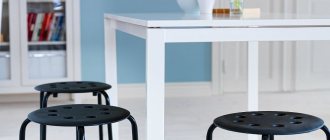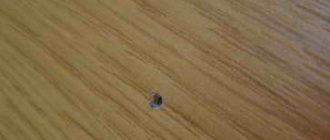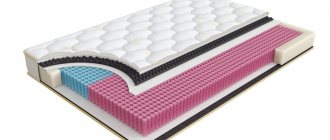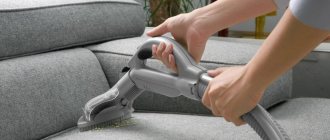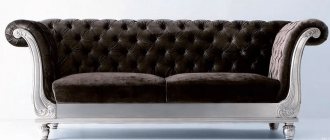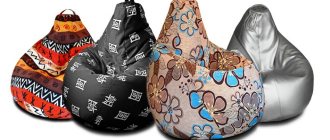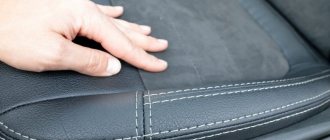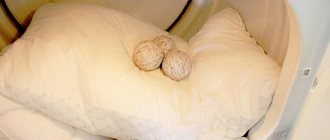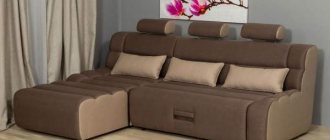Comfort, style and sophistication are words inherent in fashion trends, dictating to us what to wear and the texture of the material of manufacture plays a significant role. Thanks to it, it is possible to create not only a harmonious image, but also comfort. Developments in this direction do not stop for a second and the results are the emergence of more and more new materials, with the texture of top-level raw materials, such as nubuck.
With its help, it became possible to convey conservative ideas of a strict style in shoes or, conversely, to reflect the spirit of freedom. It is often confused with suede, so let’s look in more detail at what kind of material nubuck is.
Nubuck - what kind of shoe material is it?
Most people have heard about such a material as nubuck leather, however, not everyone knows what it is and whether it has anything in common with genuine leather. Real nubuck is a type of cattle leather that has undergone special processing and tanning with mineral salts using fine substances. This processing procedure makes the material soft and elastic. It is inferior to smooth leather in moisture resistance, but superior to suede.
Characteristics and varieties
It is not at all surprising that nubuck shoes are becoming increasingly popular, because the material has many positive properties:
- high breathability;
- pleasant in tactile and aesthetic form;
- strength and wear resistance with proper care;
- good indications of resistance to mechanical load;
- practically unstretchable.
Since the material has universal properties, boots, boots, sandals and shoes are made from it. In addition, it is used in interiors as furniture upholstery; the production of nubuck gloves and handbags is also a popular trend.
In stores you can find several options for shoes made from fleecy raw materials, conditionally divided into three main groups:
| Type of nubuck | Features of nubuck shoes: pros and cons |
| Natural | Produced only from raw materials of natural origin - leather. The key advantage is good breathability, the disadvantage is additional maintenance requirements. |
| Artificial | It is made of synthetic material and in appearance is practically indistinguishable from the previous model, however, it has higher wear resistance and is not susceptible to moisture absorption. Among the shortcomings, poor breathability is noted. |
| Nubuck-oil | Made from genuine leather, which is additionally impregnated with moisture-protective agents during processing. It has high wear resistance characteristics and is easy to maintain. The main disadvantage is the high price category. |
Nubuck production
Natural nubuck is based on cattle leather. First it is tanned with chromium salts, then polished. The resulting material has many advantages, so its cost is quite high. Artificial nubuck is cheaper. It consists predominantly of polyester (70%). It also contains cotton (23%) and glue (7%). The price depends on the type of synthetic nubuck.
The woven material is made from microfiber. Polymer threads are split using special equipment, turning them into piles of different heights and frequencies. The quality of woven nubuck depends on how long the separation process takes. Compared to non-woven, it has a high cost, but this is justified by its excellent characteristics. The material is durable and elastic. Once stretched, it quickly returns to its original shape. This nubuck is resistant to rotting, fading and, most importantly, has water-repellent and antistatic properties.
Another type of artificial nubuck (non-woven) is produced by adding looped threads (from which a pile is formed), as well as by flocking. This is the process of creating a textile covering on a surface. Short, chemically treated fibers are glued perpendicular to the base. This is how flock is produced - a well-known non-woven textile that is widely used in furniture upholstery.
To make artificial nubuck easily repel water, it is coated with Teflon. In this form, it becomes resistant not only to moisture, but also to various contaminants. In addition, nubuck is glued to a backing (laminated), which gives it rigidity. Strengthened, it does not bubble, stretch or wrinkle. This is especially important for furniture upholstery, which must fit tightly to the frame. Compared to single-layer nubuck, laminated (duplicated) nubuck is smoother.
There is another type of nubuck - nubuck-oil, however, it has nothing to do with polymers. This is a material made from genuine leather and impregnated with a special oil composition. Thanks to the fatty film, it repels moisture better and is less demanding to care for. Externally, nubuck oil is darker and smoother than the classic version. It feels heavy and damp.
Faux nubuck shoes, reviews
Each material has its own artificial analogues, differing in a cheaper price category. Also, nubuck products have their synthetic counterparts, which are a polymer pie. Manufacturers use the latest technologies, which allows them to create an ideal resemblance to a natural product, but at a more favorable price. Meanwhile, despite its cheapness, the wear resistance of artificial nubuck is at a fairly high level, but poor ventilation still remains the biggest disadvantage of this product.
What is the difference between nubuck and suede
Each of these materials is given its rightful place in the collections of designers. They are suitable for sewing not only shoes, but also outerwear, as well as accessories. When choosing a new material, the question remains: what is better, nubuck or suede:
- Production raw materials. Natural suede is essentially deerskin. Cattle are used to make nubuck.
- Tanning method. Fatliquoring remains an unchanged method for suede; chrome plating is mainly used for nubuck.
- Wear resistance. Suede still has the best durability indicators.
Caring for nubuck
Nubuck looks very interesting and dignified, which is why it attracts the attention of buyers when choosing not only shoes for any season, but also as an upholstery material. If you have definitely decided for yourself that you prefer this particular option, at the same time as you make the purchase of the main product or fabric for upholstery, purchase the necessary care products and accessories.
Important! It is advisable that care aids be produced under the same brand as the fabric or shoes themselves.
To care for nubuck you will need:
- Aerosol protective sprays. As a rule, these are moisture-repellent and antistatic agents that prevent contamination. The product must be processed immediately after purchase upon arrival home. Then - as needed, for example, before going outside in nubuck shoes in slushy or snowy weather.
- Special brushes. Sponges and hard brushes for smooth leather are not suitable for cleaning nubuck, and suede care tools will not be very easy to use. Therefore, buy exactly those marked “for nubuck” - they have optimal rigidity and length/working surface area.
- If you need to thoroughly clean the material from difficult stains, but you don’t have a special product at hand, use a not very concentrated solution of ammonia. You will need a couple of drops of alcohol per 1 tbsp. water.
- Another way to clean is to hold the product over steam and wait until the lint straightens. Next, just walk over the surface with a brush and all the dirt will come off.
How to distinguish nubuck from a fake
Since nubuck is a natural material, it not only has good ventilation, but also quickly absorbs moisture. To check, if you wet it, the effect of water will manifest itself immediately - the natural material will become noticeably darker.
For artificial raw materials, such manifestations are unusual, because the material has a multi-layer structure that does not allow moisture to pass through, but has a longer service life.
If you plan to purchase a leather product, you must also pay attention to the label. Its material is always identical to the material of the purchased product. Where natural animal skin was used, its image is presented on the label, for an artificial composition - the value of a diamond.
It is also possible to identify genuine leather by its letter name. Mostly shoes are foreign-made, so the information will be in the language of the manufacturing country:
- English – genuine leather;
- German – echtleder;
- Italian – vera pelle;
- French – cuir.
Caring for nubuck shoes
Having found out what kind of nubuck material it is, let’s move on to the rules for caring for nubuck shoes. First of all, let us note that the care process should begin from the first day of wear and this type of skin is one of the most capricious to care for. For these purposes the following methods are used:
- First appearance. When purchasing a new product, we undoubtedly have to wear it on the same day, but in the case of this material, we should initially treat it with water-repellent impregnation for nubuck shoes. Please read the instructions for this product first. Most often it is necessary to apply it in several stages with intervals for each layer to dry completely. A similar procedure is performed every time after a walk in wet weather. The following manufacturers of waterproof emulsions are characterized by excellent quality: Collonil Biwax Spray, Saphir Medaille, TARRAGO Nano Leather Refresh, Salamander Universal SMS.
- Proper cleansing. When cleansing with special products, you do not need to put a lot of effort and put pressure on the skin. Careful and gentle handling is what is required to keep the shoes in their original condition. Rubberized brushes designed specifically for suede and nubuck are used as assistants.
- Dry cleaning. After walking, the shoes are cleaned from dust accumulation with a dry metallic brush.
- Wet cleaning. The next stage of daily care involves evenly spraying the spray over the surface. It is selected based on the color of the shoes. Well-established manufacturers: Salamander, Erdal, Collonil, Sitil, Saphir, Kiwi, Silver.
- Drying. The previous stage is not the last in the procedure; after it, the shoes need to be dried; it is not recommended to go outside right away, because the deposition of dust particles will be much stronger.
Caring for a nubuck sofa
Dry cleaning of the sofa is suitable for nubuck. It is performed with a special soft brush that does not scratch the surface of the material. A sofa with such upholstery needs dry cleaning with a vacuum cleaner at least once a week. You can use cleaning wipes for nubuck. They are produced for the care of shoes and clothing. They are also suitable for regular cleaning of the sofa. It is better to clean the coating in different directions. This will not damage the pile, but will remove more dust.
Special products for cleaning nubuck can be bought at a hardware hypermarket. Read the instructions and follow them to ensure all details are observed. It can be in a spray or with a dispenser. Squeeze a little cleaning agent onto a napkin and use it to treat the dirtiest places, stains, and greasy areas.
After cleaning, treat the sofa well with a protective agent. They are packaged in economical aerosol packaging, convenient for use. Specialists from the company CLEAN EVERYTHING recommend impregnating a sofa with nubuck upholstery once every six months.
IMPORTANT : before applying protective impregnation, you should lift the pile with a nubuck brush. This way it will be protected not only from above, but also from all sides.
Do you want to calculate the cost of dry cleaning sofas? There is now a 30% discount for you!
How to clean nubuck shoes at home: what can and cannot be used?
In winter, to remove ice, utility services sprinkle roads with salt or special reagents, which does not have the best effect on nubuck shoes - white stains remain on them. In order to get rid of salt stains in winter, a special shampoo is used. However, the initial procedure is dry cleaning.
Ammonia can also be used for the same purposes. Mix it with water in a ratio of 1:4, moisten a soft sponge in the resulting mixture and wipe the contaminated areas. Next comes the drying stage. For example, you can hold it over steam. This way the fibers are straightened and the material becomes like new.
When stains appear, use a special stain remover foam for this type of material. Regular table salt can also be used. However, in this case, it will be necessary to carry out subsequent cleansing of white stains, according to the scheme described in the first option.
What procedures cannot be performed with nubuck shoes?
First of all, it is worth noting that any cleaning of a nubuck pair of shoes is carried out only on dry material, and drying should be done naturally by placing paper inside. You cannot place wet boots near the radiator, because... When dry, the leather will become rough and may burst.
The opposite situation awaits if the boots are wet and dirty. In this case, you need to wait until it dries and clean it. If you try to remove stains from wet shoes, they will be absorbed even more.
Moisture in large quantities is the worst enemy of nubuck. Therefore, when performing wet cleaning, only special products are used. It is strictly forbidden to wash shoes under the tap, machine wash or soak them. This processing method will make the shoes look unaesthetic, the structure will become rigid and it will be almost impossible to achieve the previous condition.
Caring for synthetic nubuck
Furniture covers made of artificial nubuck will not lose their appearance if you wash them at 40 degrees and iron them at temperatures up to 110 degrees. Stains that appear on the upholstery can be easily removed with ordinary liquid soap. Naturally, you can use special cleaning products. The effect will be the same. The main thing is to remember that artificial nubuck does not tolerate bleaches, solvents and alcohol-containing liquids. Drying it with a hairdryer is also detrimental to it.
What about greasy stains?! There is one trick. The contaminated area of the fabric should be sprinkled with salt and left for a while. When the grease is absorbed, remove everything with a brush or dry sponge. The final stage is cleaning the furniture with a foam detergent.
Don't be upset about spilled wine or coffee. This stain can be removed in a matter of seconds. Simply blot the nubuck upholstery with a napkin. If the liquid is completely absorbed, you will need a soap solution of 95% water and 5% any washing powder. Contamination is removed using circular movements until the stain disappears.
No matter how durable nubuck is, it does not like rough handling. In other words, when cleaning, you should not rub it, scratch it, or generally do anything that could damage the structure of the material. Otherwise, artificial nubuck is unpretentious and may well be considered the best representative of its class.
Finishing the season right - rules for preserving shoes
It must be remembered that the end of the season is an occasion for a general cleaning of all shoes, including nubuck ones. In order for the owner of boots or boots to be in excellent condition and next year, when preparing for storage, follow these tips:
- Dry naturally, remove dirt, remove the insoles and disinfect with a special aerosol.
- A spacious box with a tight-fitting lid is used for storage. There should be a hole in it for ventilation, if there is none, make it yourself. Do not place shoes in plastic bags - there is a high probability of an unpleasant odor.
- The boots will need to be aired periodically. If the material appears too dry, it is treated with an aerosol of the appropriate color, dried and placed back in the box.
Nubuck is a valuable material that is not only aesthetically attractive, but also comfortable to wear. However, it needs to be cared for daily. By adhering to the rules described above, you can significantly increase the service life of the product, without losing the original characteristics.

